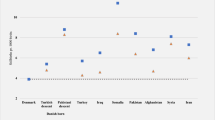Abstract
Attempts over decades have failed to eliminate the glaring inequity in birth outcomes between Americans of different races. We propose broadening the approach to dealing with racial health inequity by considering the interplay of race and class in the politics of the United States. This approach, combined with a grasp of the historical roots of race relations in North America, could hold the promise of improving our country’s abysmal showing in international comparisons of population health indicators, including birth outcomes.
This is a preview of subscription content, access via your institution
Access options
Subscribe to this journal
Receive 12 print issues and online access
$259.00 per year
only $21.58 per issue
Buy this article
- Purchase on Springer Link
- Instant access to full article PDF
Prices may be subject to local taxes which are calculated during checkout
Similar content being viewed by others
References
CSDH. Closing the gap in a generation: health equity through action on the social determinants of health. Final Report of the Commission on Social Determinants of Health. Geneva: World Health Organization; 2008. p. 1.
Centers for Disease Control and Prevention. Healthy People 2010: Overview. 2011. https://www.cdc.gov/nchs/data/hpdata2010/hp2010_final_review_overview.pdf.
Satcher D, Fryer GE, McCann J, Troutman A, Woolfe SH, Rust G. What if we were equal? A comparison of the Black-white mortality gap in 1960 and 2000. Health Aff. 2005;24:459–64.
Centers for Disease Control and Prevention, Morbidity and Mortality Weekly Reports (MMWR), QuickStats: Infant Mortality Rates, by Race and Hispanic Ethnicity of Mother — United States, 2000, 2005, and 2010, available at https://www.cdc.gov/mmwr/preview/mmwrhtml/mm6301a9.htm. Accessed 13 Sept 2020.
National Research Council (US). Institute of Medicine (US). In: Woolf SH, Aron L, editors. U.S. Health in International Perspective: Shorter Lives, Poorer Health. Washington (DC): National Academies Press (US); 2013. Summary. https://www.ncbi.nlm.nih.gov/books/NBK154469/.
Organization for Economic Co-operation and Development, OECD.Stat, Health Status: Maternal and infant mortality, available at https://stats.oecd.org/index.aspx?queryid=30116. Accessed 13 Sept 20.
Centers for Disease Control and Prevention, National Center for Health Statistics, available at https://www.cdc.gov/nchs/data/hus/2017/015.pdf. Accessed 24 Sept 20.
Annie E. Casey Foundation, Kids Count Data Center, Infant mortality by race in the United States, available at https://datacenter.kidscount.org/data/tables/21-infant-mortality-by-race#detailed/1/any/false/37,871,870,573,869,36,868,867,133,38/10,11,9,12,1,13/285,284. Accessed 9 Sept 20.
Centers for Disease Control and Prevention, CDC Newsroom Releases, Available at https://www.cdc.gov/media/releases/2019/p0905-racial-ethnic-disparities-pregnancy-deaths.html. Accessed 19 Sept 20.
Schroeder SA. American health improvement depends upon addressing class disparities. Preventive Med. 2016;92:6–15.
Isaacs SL, Schroeder SA. Class – the ignored determinant of the nation’s health. N. Engl J Med. 2004;351:1137–42.
Braveman PA, Cubbin C, Egerter S, Williams DR, Pamuk E. Socioeconomic disparities in health in the United States: What the patterns tell us. Am J Pub Health. 2010;100:S186–196.
Martin JA, Kochanek KD, Strobino DM, Guyer B, MacDorman MF. Annual Summary of Vital Statistics—2003. Pediatrics. 2005;115:619–34.
McGinnis JM, Williams-Russo P, Knickman JR. The case for more active policy attention to health promotion. Health Aff. 2002;21:79–93.
Dole N, Savitz DA, Hertz-Picciotto I, Siega-Riz AM, McMahon MJ, Buekens P. Maternal stress and preterm birth. Am J Epidemiol. 2003;157:14–24.
Wilkinson R, Marmot M, ed. Social determinants of health: the solid facts. 2nd ed. WHO; 2003.
Marmot M, Wilkinson RG. Psychosocial and material pathways in the relation between income and health: a response to Lynch et al. BMJ. 2001;322:1233–6.
Elo IT, Hendi AS, Ho JY, Vierboom YC, Preston SH. Trends in non-Hispanic white mortality in the United States by metropolitan-nonmetropolitan status and region, 1990—2016. Popul Dev Rev. 2019;45:549–83.
Organization for Economic Co-operation and Development, OECD Data, Income Inequality, Available at https://data.oecd.org/inequality/income-inequality.htm. Accessed 20 Sept 2020.
Muntaner C, Lynch JW, Hillemeier M, Lee JH, David R, Benach J, et al. Economic inequality, working-class power, social capital, and cause-specific mortality in wealthy countries. Int J Health Serv. 2002;32:629–56.
Tikkanen RS, Eric C, Schneider EC. Social spending to improve population health — Does the United States spend as wisely as other countries? N. Engl J Med. 2020;382:885–7.
Braveman P, Heck K, Egerter S, Parker Dominguez T, Rinki C, Marchi KS, et al. Worry about racial discrimination: A missing piece of the puzzle of Black-White disparities in preterm birth? PLoS ONE. 2017;12:e0186151.
Kawachi I, Daniels N, Robinson DE. Health disparities by race and class: Why both matter. Health Aff. 2005;24:343–52.
López IH. Merge left: fusing race and class, winning elections, and saving America. New York: The New Press; 2019.
Bennett L. The Shaping of Black America. Chicago: Johnson 364 Publishing Co., 1975, pp. 61–82. Available at Bennett L The Shaping of Black America. Chicago: Johnson Publishing Co., 1975, pp. 61–82. https://multiracialunity.org/2016/05/22/the-road-not-taken-by-lerone-bennett/. Accessed 24 Sept 2020.
David R. Inequity at birth and population health. Arch Dis Child 2019;104:929–30.
Kendi IX. How to Be an Antiracist. New York: One World Publishers; 2019.
Author information
Authors and Affiliations
Corresponding authors
Ethics declarations
Conflict of interest
The authors declare that they have no conflict of interest.
Additional information
Publisher’s note Springer Nature remains neutral with regard to jurisdictional claims in published maps and institutional affiliations.
Rights and permissions
About this article
Cite this article
David, R., Collins, J.W. Why does racial inequity in health persist?. J Perinatol 41, 346–350 (2021). https://doi.org/10.1038/s41372-020-00885-8
Received:
Revised:
Accepted:
Published:
Issue Date:
DOI: https://doi.org/10.1038/s41372-020-00885-8
This article is cited by
-
Culturally competent care in the neonatal intensive care unit, strategies to address outcome disparities
Journal of Perinatology (2022)
-
Infant Mortality Rates Among US-Born and Foreign-Born Latinx Women: The Effect of Black Race
Maternal and Child Health Journal (2022)
-
Critical disparities in perinatal health—understanding risks and changing the outcomes
Journal of Perinatology (2021)



